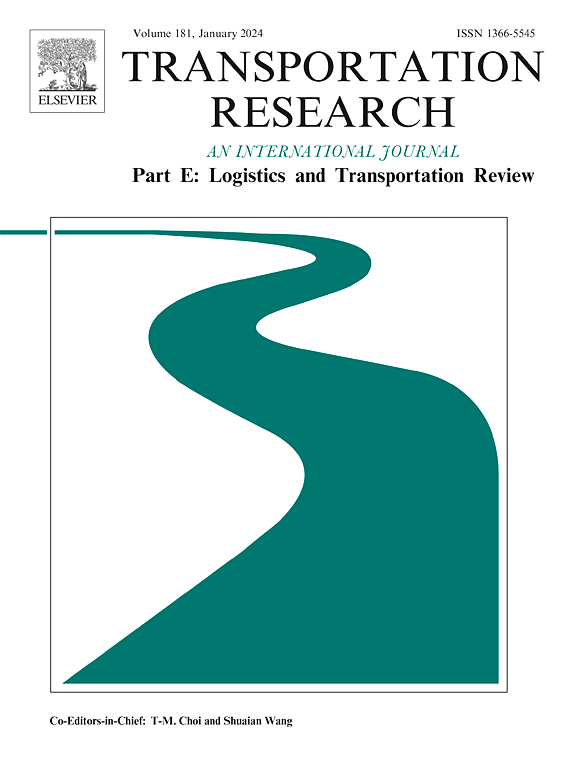An adaptive genetic hyper-heuristic algorithm for a two-echelon vehicle routing problem with dual-customer satisfaction in community group-buying
IF 8.3
1区 工程技术
Q1 ECONOMICS
Transportation Research Part E-Logistics and Transportation Review
Pub Date : 2025-02-01
DOI:10.1016/j.tre.2024.103874
引用次数: 0
Abstract
This study focuses on a novel variant of the classical two-echelon vehicle routing problem (2E-VRP), termed the two-echelon vehicle routing problem with dual-customer satisfaction (2E-VRP-DS) (i.e. time windows satisfaction and freshness satisfaction) in community group-buying. It is important to obtain better solutions for the 2E-VRP-DS with long-distance distribution in the first echelon and last-mile delivery in the second echelon. Therefore, a new mathematical model is established for the 2E-VRP-DS that incorporates objectives: minimising the total distribution costs, and maximum dual-customer satisfaction (time windows satisfaction, and product freshness satisfaction). To solve the mathematical model, an efficient adaptive genetic hyper-heuristic algorithm (AGA-HH) was proposed, complemented by a k-means clustering approach to generate initial solutions. The adaptive genetic algorithm is considered to be a high-level heuristic, and ten local search operators were considered as low-level heuristics to expand the search region of the solution and achieve robust optimal results. Three sets of experiments were conducted, and the results demonstrated the superiority of AGA-HH in solving the 2E-VRP-DS, showing improvements in distribution costs reduction, time windows compliance, and product freshness preservation. Moreover, sensitivity analyses were carried out to show the influence of the number of DCs and the tolerance range of product freshness, discovering some managerial insights for companies. Future work should consider and investigate VRPs in other new business modes.
基于自适应遗传超启发式算法的社区团购双顾客满意两梯队车辆路径问题
本文研究了经典双层车辆路径问题(2E-VRP)的一个新变体,即社区团购中具有双重顾客满意度(即时间窗满意度和新鲜度满意度)的双层车辆路径问题(2E-VRP- ds)。对于第一梯队长距离配送、第二梯队最后一英里配送的2E-VRP-DS来说,获得更好的解决方案是非常重要的。因此,为2E-VRP-DS建立了一个新的数学模型,该模型包含以下目标:最小化总分销成本,最大化双重客户满意度(时间窗口满意度和产品新鲜度满意度)。为了求解数学模型,提出了一种高效的自适应遗传超启发式算法(AGA-HH),并结合k-means聚类方法生成初始解。将自适应遗传算法作为一种高级启发式算法,将10个局部搜索算子作为低级启发式算法,以扩大解的搜索区域并获得鲁棒最优结果。进行了三组实验,结果表明AGA-HH在解决2E-VRP-DS方面具有优势,在降低配送成本、遵守时间窗和产品新鲜度方面表现出改善。此外,还进行了敏感性分析,以显示dc数量和产品新鲜度公差范围的影响,为公司提供了一些管理见解。未来的工作应该考虑和研究vrp在其他新商业模式中的应用。
本文章由计算机程序翻译,如有差异,请以英文原文为准。
求助全文
约1分钟内获得全文
求助全文
来源期刊
CiteScore
16.20
自引率
16.00%
发文量
285
审稿时长
62 days
期刊介绍:
Transportation Research Part E: Logistics and Transportation Review is a reputable journal that publishes high-quality articles covering a wide range of topics in the field of logistics and transportation research. The journal welcomes submissions on various subjects, including transport economics, transport infrastructure and investment appraisal, evaluation of public policies related to transportation, empirical and analytical studies of logistics management practices and performance, logistics and operations models, and logistics and supply chain management.
Part E aims to provide informative and well-researched articles that contribute to the understanding and advancement of the field. The content of the journal is complementary to other prestigious journals in transportation research, such as Transportation Research Part A: Policy and Practice, Part B: Methodological, Part C: Emerging Technologies, Part D: Transport and Environment, and Part F: Traffic Psychology and Behaviour. Together, these journals form a comprehensive and cohesive reference for current research in transportation science.

 求助内容:
求助内容: 应助结果提醒方式:
应助结果提醒方式:


